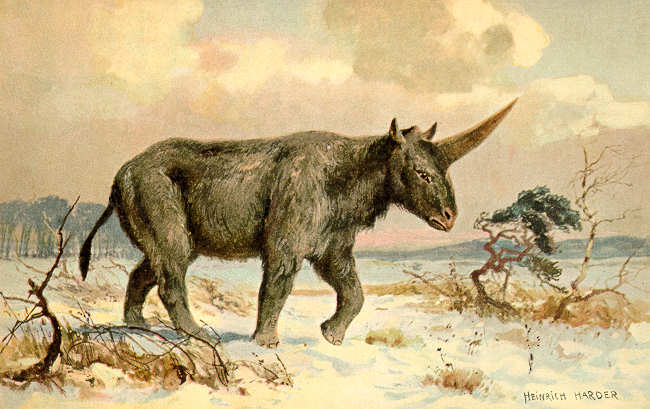The first people could meet unicorns - though not quite like you thought.

The fossilized remains of an ancient mammal Elasmotherium sibiricum ( Elasmotherium ) were found on the banks of the Irtysh near Kozhamzhar village in Pavlodar region by biologists from Tomsk State University. Its distinctive feature was the only long thick horn. According to the structure of its jaws and teeth, it is clear to scientists that the Elasmotheries fed on the underground parts of the plants - tubers and bulbs.
A typical type of elasmotria, Elasmotherium sibiricum, was described by Fisher von Waldheim in 1808. It comes from the early-middle Pleistocene of Ukraine, the Volga region, the Trans-Volga region, the Ural region, Uzbekistan, Siberia, Kazakhstan, and China. It was probably covered with wool, since it is part of the Khazar fauna that existed in the era of maximum glaciation.
Previously, it was already suggested that the Elasmotheries lived to the late Pleistocene, and the first people met him. In a cave in France, there is a drawing that depicts a large humpback rhino with a single long horn. But earlier the age of the freshest remains of this animal was dated to 350000 years.
However, the age of the remains from Pavlodar region using radiocarbon analysis was estimated at 26,000 years. And according to the generally accepted opinion, the emergence of modern people took place no later than 130,000 years ago .
Elasmotherium was similar to the modern rhino, though it was pretty hairy. He was 2 meters tall, 5 meters long, and weighed about 4 tons. The found skull belonged to an elderly male. According to scientists, the elasmotherium could survive for so long, either by finding a relatively warm spot in Western Siberia, or by periodically migrating to the southern regions.
“Our research changes the understanding of the state of the environment in that geological epoch,” says one of TSU researchers, Andrei Shpansky. “Understanding the past will allow us to make more accurate predictions of the natural processes that await us in the future.”
The discovery of the remains of an ancient mammal proves that the "unicorns" for a long time lived in the southeastern part of the West Siberian Plain and could easily meet with a man. Therefore, the cave paintings of primitive people depicting animals with one big horn may not be fantasy, and Elasmotherium sibiricum may indeed be the prototype of the fairytale unicorn of myths.
